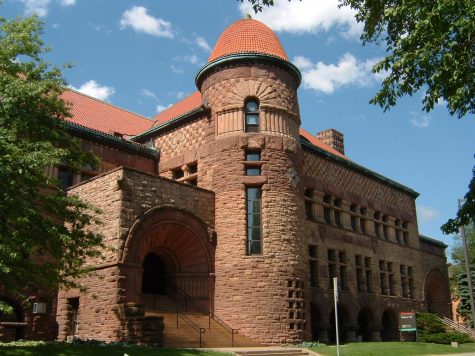The U’s Oldest Buildings and Their Surprising Pasts
November 16, 2022
With the University of Minnesota being founded in 1851, there’s bound to be some old buildings around campus. With this article, I hope to point you history fans towards the oldest buildings on campus and provide some backstory to kickstart your interest.
Starting off with the oldest surviving building on the Minneapolis campus, Eddy Hall was originally built in 1886 to serve as the school’s mechanical arts building. Throughout the years, the building has been home to the school of business, the department of Spanish and Portuguese Studies, administrative services, and the University radio station KUOM, in addition to the time it spent housing the mathematics and engineering departments. The building fell into disrepair around a decade ago and while a multi-million dollar rehabilitation and renovation project was proposed in 2011, the University was unable to secure the funding needed to carry out the renovations and the project has stalled since. While the building has remained empty in recent years, there may be hope for the building to one day reopen its doors as a major upgrade for the entire Knoll area (the oldest part of campus where Eddy resides) has been gaining traction since 2019.

Next, we’ll look at one of the most influential buildings in the University’s history, Pillsbury Hall. In the 1880s the agricultural school almost split from the University, but John S. Pillsbury agreed to pay for all $150,000 of the construction costs of a new science building for the university. Completed in 1889, the new building, named after John S. Pillsbury has been home to several science departments throughout its history. However, the University’s nationally-renowned English department has been attempting to relocate to Pillsbury since the 1990’s. The department got their wishes recently when Pillsbury underwent a full interior renovation in 2019 with classrooms and learning facilities specifically designed for the English department. After it reopened in 2021, the new home of the English department has remained one of the most iconic buildings on the Twin Cities campus.
Built in 1890, Nicholson Hall was originally known as the Chemistry Laboratory Building as it housed the department until it grew into the School of Chemistry. After the School of Chemistry moved buildings, Nicholson became home to the Minnesota Union and the Campus Club, the University’s all-male student and faculty clubs. In 1940 these clubs moved into Coffman Memorial Union and Nicholson Hall was transformed into a U.S. Navy training facility during World War II. Nicholson has been a topic of controversy in recent years as the building was almost renamed due to the discriminatory practices of Edward Nicholson, a former Chemistry professor and Dean of Student Affairs.
Nicholson became the first Dean of Student Affairs in 1917, a position he held until 1941. As Dean, he actively spied on University faculty and students for Republican politician Ray P. Chase, together working to end the influence of the Farmer-Labor Party at the University of Minnesota and in Minnesota state politics. Chase’s papers at the Minnesota Historical Society contain letters and documents sent to him by Nicholson containing the names of faculty and students whose political positions opposed his and also provided the FBI the names of student activists.
Nicholson also controlled what information students could propagate about political activities, who served in student government, and influenced the leadership of the Minnesota Daily in order to keep leftist ideas off campus. Despite the controversial actions of its namesake, the Board of Regents rejected the proposal to rename Nicholson Hall in 2019 and the hall still serves as the home of the University Honors Program and the Writing Center and has been a fundamental part of the revitalization of the Knoll area of campus.
The sheer size of the University of Minnesota’s Twin Cities campus leaves limited funds divided between a plethora of ongoing and future renovation projects. Moving forward we have to be smart about our allocation of funds if we want to preserve the history of our campus and provide students with the state-of-the-art facilities required to be a leader in higher education.











